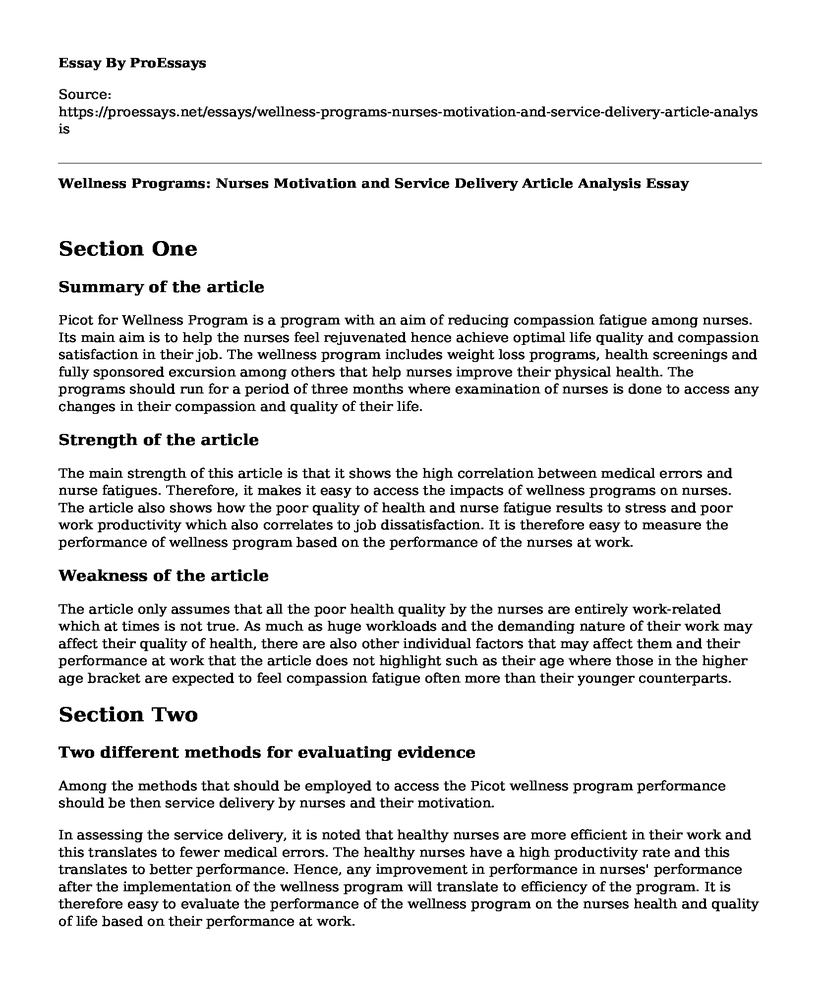Section One
Summary of the article
Picot for Wellness Program is a program with an aim of reducing compassion fatigue among nurses. Its main aim is to help the nurses feel rejuvenated hence achieve optimal life quality and compassion satisfaction in their job. The wellness program includes weight loss programs, health screenings and fully sponsored excursion among others that help nurses improve their physical health. The programs should run for a period of three months where examination of nurses is done to access any changes in their compassion and quality of their life.
Strength of the article
The main strength of this article is that it shows the high correlation between medical errors and nurse fatigues. Therefore, it makes it easy to access the impacts of wellness programs on nurses. The article also shows how the poor quality of health and nurse fatigue results to stress and poor work productivity which also correlates to job dissatisfaction. It is therefore easy to measure the performance of wellness program based on the performance of the nurses at work.
Weakness of the article
The article only assumes that all the poor health quality by the nurses are entirely work-related which at times is not true. As much as huge workloads and the demanding nature of their work may affect their quality of health, there are also other individual factors that may affect them and their performance at work that the article does not highlight such as their age where those in the higher age bracket are expected to feel compassion fatigue often more than their younger counterparts.
Section Two
Two different methods for evaluating evidence
Among the methods that should be employed to access the Picot wellness program performance should be then service delivery by nurses and their motivation.
In assessing the service delivery, it is noted that healthy nurses are more efficient in their work and this translates to fewer medical errors. The healthy nurses have a high productivity rate and this translates to better performance. Hence, any improvement in performance in nurses' performance after the implementation of the wellness program will translate to efficiency of the program. It is therefore easy to evaluate the performance of the wellness program on the nurses health and quality of life based on their performance at work.
The other method of evaluation is based on the nurses' motivation at work. Wellness programs may help the nurses engage in team projects and social focus groups which may improve their communication skills. On the other hand, it may motivate them to enjoy their work more which may rejuvenate them. As a result, it may help them do away with stress and depression reducing instances of compassion fatigue.
Comparing and contrasing the two methods
The two methods are based on the performance of the nurses as both motivation and service delivery are performance based. The benefits of both translate to benefits to the patients as they get to enjoy more when the productivity of nurses improves.
Conclusion
Therefore, wellness programs should always be implemented to overcome the compassion fatigue of nurses while also improving their mental health. For better delivery of services, the organization should ensure that nurses are well taken care of first, and programs such as group discussions are enhanced to motivate them and help them overcome stress that may result from their nature of work. Hence, I fully support the Wellness program for nurses.
References
Arian, M., Soleimani, M., & Oghazian, M. (2018). Job satisfaction and the factors affecting satisfaction in nurse educators: A systematic review. Journal Of Professional Nursing, 34(5), 389-399. DOI: 10.1016/j.profnurs.2018.07.004
McKinley, T. F., Boland, K. A., & Mahan, J. D. (2017). Review: Burnout and interventions in pediatric residency: A literature review. Burnout Research, 69-17. DOI:10.1016/j.burn.2017.02.003
Sinclair, S., Raffin-Bouchal, S., Venturato, L., Mijovic-Kondejewski, J., & Smith-MacDonald, L. (2017). Compassion fatigue: A meta-narrative review of the healthcare literature. International Journal Of Nursing Studies, 69, 9-24. doi: 10.1016/j.ijnurstu.2017.01.003
Wang, K., Chou, C., & Lai, J. (2018). A structural model of total quality management, work values, job satisfaction and patient-safety-culture attitude among nurses. Journal Of Nursing Management, 22(1). DOI: 10.1111/jonm.12669
Webster, J., McLeod, K., O'Sullivan, J., & Bird, L. (2018). Eight-hour versus 12-h shifts in an ICU: Comparison of nursing responses and patient outcomes. Australian Critical Care, 21(12). DOI: 10.1016/j.aucc.2018.08.004
Cite this page
Wellness Programs: Nurses Motivation and Service Delivery Article Analysis. (2022, Sep 11). Retrieved from https://proessays.net/essays/wellness-programs-nurses-motivation-and-service-delivery-article-analysis
If you are the original author of this essay and no longer wish to have it published on the ProEssays website, please click below to request its removal:
- Health Care Technologies - Essay Example
- Application for the School of Nursing
- Essay Example on Medicare: Federal Health Insurance Program for Seniors Above 65
- Essay Sample on Equal Health Care for All: Addressing the US Health Equity Issue
- Essay Example on Evaluating Patient Safety Culture in Nephrology Nurse Settings
- Increased Demand for Psychiatric Nurse Practitioners in Primary Care - Essay Sample
- Free Essay Example on Breast Cancer







